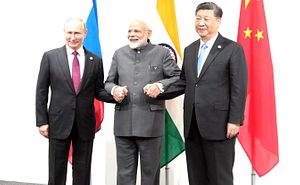During the G-20 Summit in Osaka, Russia, India, and China (RIC) held the latest iteration of a trilateral meeting between them. While the grouping itself is nothing new – the notion of meeting on the sidelines of the G-20 meeting began last year and many other meetings were held during the G-20 meeting this year as well – the RIC nonetheless stole the headlines this year.
RIC as a strategic grouping first took shape in the late 1990s under the leadership of Yevgeny Primakov as “a counterbalance to the Western alliance.” Primakov, a Russian politician and diplomat who was also the prime minister of Russia from 1998 to 1999, is credited with the idea for RIC. The group was founded on the basis of “end[ing] its subservient foreign policy guided by the U.S.,” and “renewing old ties with India and fostering the newly discovered friendship with China.”
But the idea of meeting at the leader’s level on a more sustained basis has only surfaced over the past couple of years. The three sides had done so last year at the G-20 meeting in Argentina, where there was also a focus on the trilateral summit between the United States, India and Japan, called JAI (Japan, America, India). And on the sidelines of the Shanghai Cooperation Organization (SCO) meeting in Kyrgyzstan, the leaders agreed to meet again in Osaka during the G-20 Summit.
The RIC meeting this year is only the third heads of state meeting of the group in 12 years, which speaks to the state of the play among the three countries in nurturing this strategic grouping. Nonetheless, in the current period of geopolitical transition, there is an effort to renew and rebuild some of these old initiatives as a way to counter the U.S.-led world order.
These efforts started in Bishkek, when Russian President Vladimir Putin, Indian Prime Minister Narendra Modi, and Chinese President Xi Jinping held separate bilateral meetings on the sidelines of the SCO Summit. Reports speak of great “personal chemistry between Putin, Xi and Modi” that has “worked wonders.” While the Russia-China leg of the triangle has been fairly strong in the last few years, Modi has also had reasons in recent times to cozy up to Russia and China in the wake of U.S. President Donald Trump’s tariff war with India, especially since the Trump administration has withdrawn India’s Generalized System of Preferences (GSP) and imposed tariffs on Indian goods.
To be sure, India has remained a key partner in the United States’ Free and Open Indo-Pacific Strategy, and Modi too has sought a close strategic partnership with the United States in an effort to address China’s rising power. But the recent trade and tariff war may cast a negative shadow on the broader U.S.-India strategic ties, which stands to advantage China and Russia. It is no coincidence that the RIC meeting and the strengthened bonhomie among the three leaders has come amid these difficulties between the United States and India. While U.S. Secretary of State Mike Pompeo was in India in late June to assuage some of the growing difficulties in the India-U.S. bilateral ties, the trip, as well as Pompeo’s statement “Modi hai toh Mumkin Hai” (“Modi makes it possible”), did very little to change the broader strategic dynamics with New Delhi.
In this respect, how the RIC meeting was perceived and portrayed at G-20 in Osaka came as no surprise. Unlike the second edition of the JAI Summit, which did not get much attention, the RIC meeting was trumpeted as a major success for developing economies, emphasizing the need for free and open markets, and opposing any efforts at protectionism, all clearly targeting Trump’s America. Clearly, Xi and Putin pitched this at the ideal moment, when New Delhi is the latest of many who have come under Trump’s tariff war.
Modi, in his opening remarks to the RIC meeting in Osaka, underlined the importance of the RIC grouping and the exchange among the three on the global economic, political, and security situation. He highlighted the usefulness of the exchange of views at the earlier meeting of the RIC foreign ministers in China in February. Modi said that the foreign ministers had discussed all important issues including “promotion of counterterrorism, international hot-spot issues, reformed multilateralism, climate change and cooperation under RIC.”
Xi, for his part, is reported to have emphasized the importance of the three countries in the context of upholding multilateralism. He urged the leaders of Russia and India to assume “global responsibility” to defend their national interests while pushing for a multilateral world order. Xi went on to add that “the rise of protectionism and unilateralism has severely affected global stability and economic growth, as well as the existing international order which emerging economies and developing countries have relied on.” Clearly, Xi was trying to muster greater support amidst the ongoing U.S.-China trade war.
It is not clear how Modi will weather the tariffs issue, and New Delhi may not find much relief by going with the RIC to address this issue. While Modi has to be mindful of the charm offensive by Xi and Putin, which obviously works to their own self-interest because of their own difficulties with the United States, Washington must also play its cards carefully and not let New Delhi fall into Beijing’s lap. The United States and India must ensure their current trade and tariff issues do not lead to serious strategic disagreement. The two cannot afford to miss the emerging geopolitical realities driven by China’s growing power. So far, the United States and India have been able to more or less maintain the momentum in the relationship and it has been mutually beneficial. It is too early to say if the calculations are changing.

































